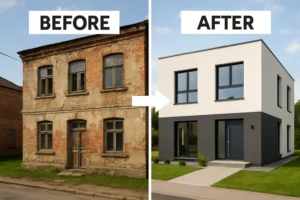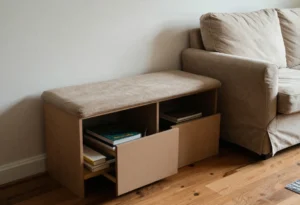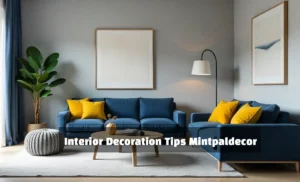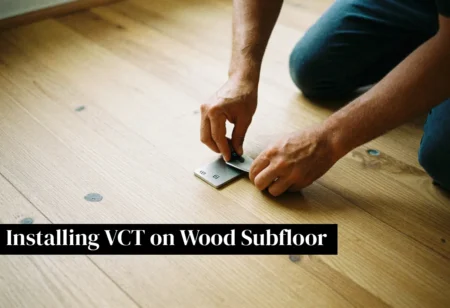The flooring of a home is like the foundation of an outfit – it ties the entire space together and sets the tone for the decor. Choosing the right flooring solution can elevate the style and comfort of a home. With so many options to pick from, it may seem overwhelming to select the perfect floors for your needs. This comprehensive guide will walk you through the essential factors to consider when choosing a flooring solution for your home. Discover the latest flooring trends, types of materials, proper installation, care and maintenance tips to make the floors last. By the end, you’ll be equipped with the knowledge to find the ideal floors to enhance your home.
Introduction
The flooring of a house serves both aesthetic and functional purposes. It impacts how the home looks and feels while providing a durable surface for daily activities. With the floor occupying such a large surface area, its design and material have a powerful influence on the home’s overall style. Meanwhile, the practical qualities of the flooring solution determine how well it endures foot traffic, décor, furniture placement, and potential damage over time.
This article will explore the spectrum of flooring solutions available for homes today. We will compare the pros and cons of various material types so you can determine which works best for your lifestyle and interior design vision. You’ll learn the newest flooring trends that add style and value to homes. We’ll also cover the critical factors to evaluate when selecting floors for specific rooms based on their purpose and usage. Proper installation and upkeep are key to maximizing the lifespan of flooring, so you’ll find tips for maintenance and professional installation as well. Follow along as we delve into the essential considerations for choosing the best flooring solution for your home.
Types of Flooring Solutions
Home flooring solutions fall into two main categories: hard surface and soft surface. Hard surface floors include stone, tile, concrete, vinyl and wood. Meanwhile, soft surface flooring encompasses choices like carpet, cork, bamboo, and laminate. Within each category, the materials provide unique advantages and limitations. As you evaluate options, narrow down your selection by assessing the performance, look and cost of each type of flooring.
Hard Surface Floors
Stone Tile
Made from natural stone like marble, travertine, slate and granite, stone tile flooring delivers unmatched durability and timeless elegance. The aesthetic quality of natural stone introduces distinctive veining, colors and texture based on the type of material. Stone tile floors work beautifully in bathrooms, kitchens, foyers and other high-traffic areas of the home. The material naturally resists moisture, stains and scratches. However, stone comes at a significant cost for the purchase and installation. The hard surface can also feel uncomfortable for standing over long periods.
Ceramic and Porcelain Tile
For a more affordable and versatile tiled floor compared to natural stone, ceramic and porcelain present excellent options. Glazed ceramic tile provides a glossy surface that’s easy to clean, while the unglazed type has a matte finish with more texture. Porcelain tile comes unglazed for a natural matte look or glazed for sheen. Both ceramic and porcelain tiles stand up well to heavy usage in kitchens, bathrooms and laundry rooms. They resist water, stains, odors and wear. Tile also runs cooler than other flooring types. The hard surface can be slippery, so exercise caution when wet.
Concrete
Modern stained and polished concrete floors provide a durable, industrial-chic look. Concrete offers superior strength over other flooring materials, withstanding heavy foot traffic and furniture placement. Minimal care is required for maintenance. But concrete remains hard and cold underfoot. The installation also carries higher labor costs. Adding a sealant coat and utilizing radiant floor heating systems can enhance comfort. Overall, concrete floors work best in contemporary or industrial spaces.
Luxury Vinyl Plank
For a flooring solution that mimics the look of natural materials at a fraction of the cost, luxury vinyl plank floors fit the bill. Advanced printing technology allows vinyl planks to recreate visuals of hardwood, stone and tile with stunning realism. The planks install by clicking together without glue, making them a DIY-friendly flooring choice. Vinyl floors perform well in humidity and resist stains, scratches and dents. Underfoot, they feel softer and warmer than natural stone, tile or concrete. However, the planks can crack or warp if exposed to extreme temperature changes.
Laminate Flooring
Constructed as a composite wood core topped with a photographic image layer, laminate flooring simulates the look of solid hardwood or stone. The durable laminate surface protects against moisture, stains, scratches and fading. Laminate wood planks provide affordable style and are easy to install as a floating floor without nails or glue. However, laminate cannot be refinished like solid wood. The material also lacks good water resistance. Frequent spills or flooding can lead to damage and warping.
Hardwood Floors
For timeless warmth and character, genuine hardwood floors have stood the test of time. Customizable in plank shape, finish and staining, hardwood offers unrivaled richness. Oak, maple, hickory, cherry and exotic species each exhibit distinctive grain patterns, hues and textures. Hardwoods create a refined, traditional mood that increases a home’s resale value. They also allow sanding and refinishing to restore their appearance. But hardwood is susceptible to scratching, moisture damage, and requires considerable care. Proper installation and climate control are vital for hardwood longevity.
Soft Surface Flooring
Carpeting
Plush wall-to-wall carpeting delivers luxurious softness and insulation. Hundreds of carpet styles range from sumptuous to affordable synthetic and wool materials. Carpeting absorbs sound, provides comfort underfoot and improves slip-resistance. However, carpets trap allergens and require considerable maintenance. Moisture, stains and heavy traffic take a toll, shortening carpet lifespan. Professional steam cleaning is necessary to keep carpets fresh and hygienic. The padding also compresses over time.
Cork
Environmentally friendly cork flooring lends warmth and softness to a home’s interiors. Made from renewable cork oak tree bark, these floors are naturally moisture-resistant, hypoallergenic, and antimicrobial. Cork feels exceptionally soft underfoot, providing cushioning and sound absorption. Available in tiles or planks, cork offers subtle organic style. However, dents and scratches require attention to avoid permanent damage. The flooring shows moisture damage if water leaks are not promptly resolved.
Bamboo Flooring
For renewable style, bamboo flooring presents a versatile option made from fast-growing grasses. Available in planks or parquet tiles, bamboo choices range from light and contemporary to rich caramelized tones. Bamboo earns high marks for durability, moisture-resistance and easy maintenance. Calm and tranquil, bamboo also exhibits sound-absorbing qualities. On the downside, bamboo floors dent easily compared to hardwoods. Exposure to water causes swelling and requires rapid cleanup.
Laminate Flooring
Constructed as a composite wood core topped with a photographic image layer, laminate flooring simulates the look of solid hardwood or stone. The durable laminate surface protects against moisture, stains, scratches and fading. Laminate wood planks provide affordable style and are easy to install as a floating floor without nails or glue. However, laminate cannot be refinished like solid wood. The material also lacks good water resistance. Frequent spills or flooding can lead to damage and warping.
Popular Flooring Trends
Staying current with the newest flooring trends allows you to elevate your home’s style while adding value and appeal. Today’s most popular flooring options lean toward natural styles that are tactile and sustainable. Materials like wood, cork and concrete create cozy ambiance with artisan character. Knowing which directions the flooring trends are moving gives you stylish and smart choices for your home’s interiors.
Natural Materials
Flooring that utilizes natural materials resonates with the return to organicism and eco-conscious lifestyles. Natural wood flooring, especially wide plank oak, remains a sought-after choice that adds timeless warmth to any home. Porcelain and ceramic tiles with authentic stone designs also capture the natural material aesthetic and durability. Beyond wood, renewable cork and bamboo floors satisfy demand for sustainability.
Textured Visuals
Floors no longer need to have a uniform, smooth appearance. Materials that showcase the knots, grains, cracks and imperfections of natural substances top today’s trends. For example, textured tiles imitate the multidimensional look of actual stone and cement. Distressed, handscraped and wire-brushed hardwood floors display artisan craftsmanship. Even carpet and rugs are incorporating organic undyed textures and free-form shapes.
Muted Tones
Vibrant colors are giving way to softer, neutral earth tones in flooring. Hues like beige, taupe and gray reflect the surge in modern farmhouse style. To further cultivate a peaceful ambiance, darker finishes such as walnut and hickory wood bring warmth without overpowering. Muted tones create continuity throughout the home by flowing from room to room. They act as a subtle backdrop that allows brighter accents and furnishings to shine. The natural muted coloration also avoids rapid décor fatigue that setting trends often incur.
Large Format Tiles
Another rising flooring trend is the use of larger tile sizes to create seamless expanses of ceramic, porcelain and stone. Where tiles were once 4 inches square, they now scale up to 12 inches, 16 inches and even larger formats. Larger grout-free tiles amplify visual spaciousness. The minimal lines and joints also streamline cleaning. This tile format follows contemporary and modern design themes toward uncluttered, open interiors. Larger tiles make a powerful impact in wide-open areas like kitchens and great rooms.
Mixed Materials
Why choose a single flooring type when you can combine materials for contrast and creativity? Mixing flooring materials in zones lets you optimize function room-by-room. For example, install hardwood in living zones and tile in wet rooms. Using different colors, grains and textures together adds interest. Mixing materials like tile and hardwood or carpet and tile follows an eclectic, blended aesthetic for unique personalized style.
Wood-look Tile
One of the hottest hybrid flooring trends combines the beauty of hardwood with the durability of ceramic or porcelain tile. These innovative tiles use digital printing technology to capture the nuances of wood grain in stunning detail. Rustic barnwood, weathered oak, exotic Brazilian walnut – all these looks get replicated in tile form. Wood-look tile floors blend into other rooms with actual hardwoods while providing greater stain, scratch and moisture resistance in high traffic areas. The mix of textures also creates dynamic contrast.
Factors to Consider When Choosing a Flooring Solution
Selecting the optimal flooring involves evaluating your home’s needs room-by-room. Analyze the functional requirements of each space based on traffic, activities and lifestyle. Identify your style goals for aesthetics and ambiance. Also realistically assess your budget, maintenance commitment and installation needs. Use the following factors as a guide when choosing flooring solutions:
Room Function and Traffic Flows
Consider a room’s purposes and usage intensity when selecting flooring. For example, kitchens demand durable surfaces like tile, stone or concrete that resist moisture, stains and wear-and-tear. Family rooms need floors that are easy to clean and able to hide scuffs, like textured carpet or vinyl plank. Formal living spaces can handle delicate materials like polished hardwoods since foot traffic is lighter. Also examine the flow of people throughout the home, choosing easy-care floors for high-traffic areas.
Style and Decor Goals
The mood you want to create influences the best flooring type for each room. For a refined ambiance, hardwood evokes timeless richness. Tile in classic patterns or natural stone establishes ornate elegance. Soft carpet creates cozy warmth ideal for bedrooms. Cork and bamboo provide casual, earthy textures. Sleek polished concrete or porcelain reflects contemporary sensibilities. Make sure the flooring’s tone and pattern complements your color scheme and furnishings.
Noise Control and Comfort
Consider noise control, temperature comfort, and underfoot feel when evaluating flooring materials. Carpets, cork and bamboo muffle footsteps, echo and sound transmission. These softer surfaces are gentle underfoot for extended standing. Hard surfaces like tile and wood click loudly under shoes. These floors also feel cold and hard to stand on without rugs. Make noise reduction and ergonomic comfort priorities for bedrooms, nurseries, and relaxation areas.
Moisture Resistance
Preventing water damage means selecting the right flooring materials for wet areas like kitchens and bathrooms. Porcelain, ceramic, stone, concrete and vinyl tiles resist water penetration. Certain engineered hardwoods and laminates offer moisture defense through their layered construction. Ensure floors can tolerate not just occasional spills but also high humidity, leaks, flooding or routine contact with water. Evaluate manufacturer water resistance classifications.
Ease of Maintenance
Realistically weigh how much time you can devote to floor care before choosing materials. Hardwood, laminate, and luxury vinyl flooring only need occasional sweeping and damp mopping for upkeep. But hardwood also requires waxing and refinishing. Tile and stone need a protective sealant applied periodically. Carpet demands frequent and thorough vacuuming along with deep cleaning every year or two. Preparedness to maintain the floors will determine which solution works best.
Installation Requirements
Factor in the complexity of installation for each flooring type. Ceramic tile requires a smooth, flat subfloor and precision application of thinset mortar. Hardwood must be nailed or glued properly to prevent warping or buckling. Carpet involves stretching and seaming for a flat appearance. Click-together vinyl plank flooring allows DIY-friendly floating installation. If tackling a DIY job, avoid floors needing extensive subfloor prep or adhesives. Also determine if you need removal of old flooring before installation.
Maintenance and Care of Flooring Solutions
The proper care and maintenance of floors ensures they look beautiful and perform well year after year. Follow the manufacturer’s recommendations to select effective cleaning products formulated for your specific flooring material. Establish a regular cleaning routine rather than just spot-treating dirt or attempting deep cleans. Address spills, stains and scratches promptly to prevent lasting damage. Also rearrange area rugs and furniture to distribute wear evenly.
Regular Upkeep
- Sweep, dust mop or vacuum floors at least weekly to remove debris and grit that can abrade flooring surfaces.
- Clean high traffic areas more often to prevent dirt and soil buildup.
- For hard surfaces, use the proper floor cleaner and mop or auto-scrub weekly.
- Thoroughly vacuum carpets and clean with spot remover weekly, and shampoo every 6-12 months.
- Reapply appropriate sealers and waxes when they begin wearing off.
Preventative Care
- Install protectants like mats at exterior doors and area rugs in heavy use areas.
- Use floor protectors and casters under furniture legs.
- Maintain proper indoor humidity levels year-round.
- Ensure spills are cleaned up immediately to avoid stains.
- Rearrange area rugs and furniture periodically to distribute wear patterns.
- Trim pet claws to avoid scratches from paws.
Damage Resolution
- Scratches in wood can often be rubbed out using basic techniques. For deeper scratches, consult a wood floor refinisher.
- Chipped or cracked tiles may need replacement by a professional installer.
- Carpet stains can be treated quickly with spot removers or extracted by a carpet cleaner.
- For pet accidents, blot urine immediately and use an enzymatic cleaner to neutralize odors.
- Address sources of moisture intrusion right away before water damage spreads.
Proper flooring care leads directly to longer lifespan. By maintaining floors routinely and resolving problems as they occur, you’ll keep any flooring solution looking it’s best for years of enjoyment.
Installation of Flooring Solutions
Installing the flooring properly ensures it functions and wears appropriately. Preparation of the subfloor creates a flat, stable, and level base on which to install the floors. Hiring a qualified professional flooring installer is recommended for flawless results. However, DIY installation works for beginners with easier “floating floor” materials. Planning the layout carefully and taking time with the installation are vital.
Hiring a Professional
Seeking professional flooring installation offers multiple advantages:
- Experts thoroughly inspect and prepare the subfloor surface to receive flooring.
- They own specialized tools that streamline difficult parts of installation.
- Professionals properly control ambient temperature and humidity during installation.
- Contractors have extensive experience correctly applying adhesives, connecting planks in wood flooring, cutting intricate tile shapes, and seaming carpets.
- Experts provide qualified assistance choosing the right materials for your home prior to installation.
DIY Installation Tips
For DIY installations, follow manufacturer instructions carefully. Watch online tutorial videos to guide you through each phase. Useful DIY flooring tips include:
- Allow materials to acclimate to your home’s temperature/humidity for 1-2 days before installing.
- Prepare the subfloor completely – remove old flooring, clean, fill cracks, level uneven spots.
- Plan planks/tiles layout to minimize cuts, waste and seams in conspicuous places.
- Use spacers between planks/tiles for even spacing, and offset end joints in rows.
- Work slowly and carefully especially when cutting tiles or tapping planks into position.
- With adhesive floors, use the proper trowel size and follow open time guidelines.
Rushing through installation may compromise quality and appearance. Allow sufficient time for careful DIY installation to avoid problems.
Pre-Installation Preparation
Whether DIY or professional, proper preparation ensures successful flooring installation:
- Have the installer verify flooring matches what was purchased and ordered.
- Inspect subfloor and remove debris, protruding nails and uneven areas.
- Check that subfloor is flat within specifications for the new flooring material.
- Conduct any needed repairs to the subfloor
- Make adjustments to ensure doors can still open and clear new floor height.
- Remove existing baseboards and moldings before installation.
- Give any new concrete floors proper cure times before installing over them.
- Have HVAC system running to keep home at normal temperature and humidity.
- Acclimate the flooring boxes by spreading them out in the rooms.
With the subfloor ready and materials on-site, you can feel confident for a smooth installation process. Take steps to keep children and pets out of work areas for safety and cleanliness. Be prepared to be flexible with furniture placement and room use during the installation timeline. Your diligence in pre-installation preparation will ensure your new flooring solution enhances your home for years of enjoyment.
Conclusion
The flooring in a home unites every space, impacting aesthetics, functionality and ambiance. With the numerous flooring solutions for residential use today, making the optimal choice requires research and forethought. Hard surfaces like wood, tile and concrete deliver durability while soft carpeting and cork offer plush comfort. Natural materials stay on-trend while larger format tiles and wood-look designs create stunning ultra-modern style.
Thinking through how each room is used, its style goals, along with maintenance, installation and comfort considerations will guide you to the right flooring type. Budget will also play a role in selecting flooring, as costs can vary widely. But you need not choose expensive materials to get great style and performance. Proper installation combined with routine care ensures your new floors look pristine for decades. Follow this comprehensive guide when evaluating the many excellent flooring solutions. Identifying what works best room-by-room will result in a home enhanced by the perfect choice of floors.



